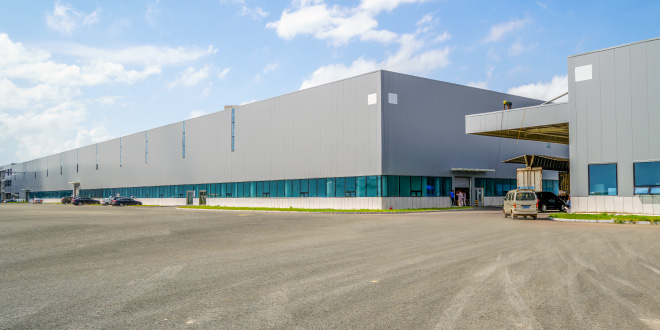Searching for a warehouse for rent in the US? Explore types, features, key considerations, and top markets. Find the perfect commercial space for your business needs.
Warehouse for Rent: Your Essential Guide to Securing US Commercial Space
In today’s dynamic business environment, finding the right warehouse for rent is more critical than ever. Whether you’re managing e-commerce fulfillment, needing secure storage, or setting up a distribution hub, the demand for adaptable industrial space across the United States is booming. The location, size, and specific features of your rented warehouse can directly impact your operational efficiency, supply chain effectiveness, and ultimately, your bottom line.
But how do you navigate the vast and often complex commercial real estate market to secure the perfect space? What should you look for beyond square footage? And which U.S. regions are currently offering the most compelling options for businesses seeking a prime warehouse for rent? This comprehensive guide will walk you through everything you need to know, from understanding different warehouse types to negotiating your lease, ensuring you make an informed decision for your business’s future.
Table of Contents
Understanding the Demand for a Warehouse for Rent in the US
The need for industrial space, particularly warehouses, has surged in recent years, driven by several key factors within the U.S. economy:
- E-commerce Boom: Online retail continues to grow exponentially, requiring vast networks of fulfillment centers and last-mile delivery hubs to meet consumer expectations for rapid shipping.
- Supply Chain Resilience: Businesses are increasingly diversifying their supply chains and holding larger inventories domestically, leading to a greater demand for strategic storage solutions.
- Manufacturing Reshoring/Nearshoring: A renewed focus on domestic production is creating a need for industrial facilities closer to raw materials and consumer markets.
- Technological Advancements: Automation and robotics in logistics require specific layouts and infrastructure within modern warehouses.
This robust demand means that businesses searching for a warehouse for rent must be strategic, well-informed, and often quick to act in competitive markets.
Types of Warehouses You Can Rent
Not all warehouses are created equal. The type of space you need will depend heavily on your specific operational requirements. Here are the primary categories of a warehouse for rent you’ll encounter in the US:
- Distribution Centers: Designed for rapid throughput of goods, with high ceilings, multiple loading docks, and efficient layouts for receiving, sorting, and shipping. Ideal for e-commerce, logistics companies, and large-scale product distribution.
- Storage Warehouses: Focused on long-term storage of goods. They might have fewer docks but prioritize security, climate control (if needed), and efficient racking systems. Good for inventory overflow, archival storage, or seasonal products.
- Manufacturing Warehouses: Include space for production alongside storage. Often feature heavier floor loads, specialized power, ventilation, and sometimes specific zoning requirements.
- Flex Space / Office-Warehouse: A hybrid option offering a combination of industrial space with dedicated office areas. Perfect for small businesses, light manufacturing, or service companies that need both administrative and operational space.
- Cold Storage Warehouses: Equipped with refrigeration and freezer capabilities, essential for food, pharmaceuticals, and other temperature-sensitive goods.
- Cross-Dock Facilities: Optimized for transferring goods directly from inbound to outbound transportation, minimizing storage time. Critical for efficient supply chains.
Key Features and Considerations When Seeking a Warehouse for Rent
Once you know the type of warehouse you need, you’ll want to dive into the specifics of each property. Here are the crucial features and factors to evaluate:
- Size & Layout:
- Square Footage: Directly impacts rent and capacity.
- Clear Height: The vertical space from the floor to the lowest obstruction (e.g., sprinklers, beams). Crucial for stacking and automation.
- Column Spacing: Wider spacing allows for more flexible racking systems and movement.
- Office Space: Is there adequate integrated office space, or will you need to build it out?
- Loading & Docking:
- Loading Docks: Number and type (dock-high, grade-level).
- Drive-in Doors: Essential for vehicles to enter the warehouse.
- Truck Court Depth: Space for trucks to maneuver and stage.
- Parking: Adequate parking for employees and truck staging.
- Power & Utilities:
- Electrical Capacity: Amperage and voltage. Critical for machinery, refrigeration, or heavy equipment.
- Utilities: Reliable access to water, sewer, and gas.
- Internet/Connectivity: High-speed internet is non-negotiable for modern operations.
- Location & Accessibility:
- Proximity to Highways/Interstates: Crucial for efficient transportation and distribution.
- Access to Ports/Railways/Airports: If your business relies on multimodal transport.
- Labor Pool: Availability of skilled and unskilled labor in the area.
- Local Zoning & Regulations: Ensure the property is zoned for your intended use.
- Security & Safety:
- Fire Suppression Systems: Sprinklers are standard.
- Security Systems: Fencing, gates, alarms, surveillance.
- Floor Load Capacity: Can the floor support the weight of your inventory and equipment?
- Lease Terms & Costs:
- Lease Type: Gross, Net, Double Net (NN), Triple Net (NNN) – understand what expenses you’re responsible for.
- Lease Length: Short-term flexibility vs. long-term stability.
- Rent Escalations: How much will rent increase over time?
- Tenant Improvement (TI) Allowance: Funds provided by the landlord for customizations.
Top US Markets for a Warehouse for Rent (Mid-2025)
The industrial real estate market in the U.S. is highly dynamic. As of mid-2025, several markets continue to lead in demand, development, and strategic importance for businesses seeking a warehouse for rent:
- Inland Empire, California: Continues to be a powerhouse due to its proximity to the Ports of Los Angeles and Long Beach, serving as a critical distribution hub for the entire Western U.S.
- Dallas-Fort Worth, Texas: A major logistics hub in the central U.S., benefiting from robust population growth, a strong labor market, and excellent transportation infrastructure.
- Atlanta, Georgia: A key gateway to the Southeast, with access to major interstates, Hartsfield-Jackson Atlanta International Airport, and a large consumer base.
- Chicago, Illinois: Remains a vital distribution point for the Midwest, with extensive rail, road, and air cargo networks.
- Phoenix, Arizona: Growing rapidly, offering affordable space compared to California, attracting e-commerce and manufacturing operations seeking expansion in the Southwest.
- Pennsylvania (e.g., Lehigh Valley, Central PA): Strategic locations offering access to the dense population centers of the Northeast and Mid-Atlantic regions.
These markets often command higher prices due to demand, but they also offer superior connectivity and infrastructure. It’s crucial to work with commercial real estate experts who understand these evolving market dynamics. For in-depth insights into current market trends and available industrial properties across key U.S. regions, a resource like nexmove.us can provide valuable guidance and listings, helping you pinpoint ideal warehouse opportunities.
Your Search Strategy: Finding the Right Warehouse for Rent
Finding the perfect warehouse isn’t just about Browse online; it requires a multi-faceted approach.
- Define Your Needs Clearly: Before you start looking, create a detailed list of your requirements: square footage, clear height, number of docks, power needs, desired location, budget, and timeline.
- Work with a Commercial Real Estate Broker: This is arguably the most crucial step. A specialized commercial real estate broker (especially one focused on industrial properties) has access to comprehensive databases, off-market listings, and invaluable local market knowledge. They can help you:
- Identify suitable properties.
- Negotiate lease terms.
- Understand market rates.
- Navigate legal complexities.
- Online Listing Platforms:
- LoopNet, Crexi, CoStar: These are the leading platforms for commercial real estate listings in the US.
- Local Brokerage Websites: Many regional brokerages have their own proprietary listings.
- Drive-by and Network: Sometimes, the best opportunities aren’t advertised widely. Drive through industrial parks in your target areas. Network with other business owners, suppliers, and logistics professionals.
- Due Diligence: Once you’ve found a potential warehouse for rent, conduct thorough due diligence:
- Physical Inspection: Beyond aesthetics, check for roof integrity, HVAC systems, loading dock functionality, and safety compliance.
- Zoning Verification: Confirm the property’s zoning permits your specific business operations.
- Environmental Assessment: Especially for older properties or those with previous industrial use, consider a Phase I environmental site assessment.
- Lease Review: Have a real estate attorney review the lease agreement carefully, understanding all clauses, responsibilities, and liabilities.
Negotiating Your Warehouse Lease
Leasing a warehouse is a significant financial commitment. Negotiation is key to securing favorable terms.
- Understand Lease Types:
- Gross Lease: Tenant pays a flat fee; landlord covers property taxes, insurance, maintenance.
- Net Lease (N), Double Net (NN), Triple Net (NNN): Tenant pays base rent PLUS a proportionate share of property taxes (N), property taxes and insurance (NN), or property taxes, insurance, and common area maintenance (CAM) (NNN). NNN is common for industrial properties.
- Term & Renewals: Negotiate the initial lease term and clear renewal options with defined rent escalation.
- Rent Escalations: Be aware of how rent increases over the lease term (e.g., fixed annual increases, CPI-indexed).
- Tenant Improvement (TI) Allowance: Funds from the landlord to build out or customize the space to your needs. Negotiate this upfront.
- Operating Expenses (OpEx) Caps: If on a NNN lease, try to cap your share of controllable operating expenses to prevent unexpected cost surges.
- Subleasing/Assignment Clauses: Understand your flexibility to sublease or assign the lease if your business needs change.
Frequently Asked Questions
What’s the typical lease term for a warehouse for rent in the US? Warehouse lease terms typically range from 3 to 10 years, with 5-year leases being very common. Shorter terms (1-3 years) may be available for smaller flex spaces or in specific situations, while larger, build-to-suit facilities might have terms of 10-20 years or more.
How is warehouse rent typically calculated? Warehouse rent is usually quoted on a “per square foot per year” basis. For example, a property listed at $12/SF/YR for a 10,000 sq ft warehouse would cost $120,000 annually, or $10,000 per month. This base rent might be part of a NNN lease, where you also pay a share of taxes, insurance, and CAM.
What’s “clear height” and why is it important for a warehouse? Clear height is the vertical distance from the warehouse floor to the lowest obstruction (like a beam or sprinkler head). It’s crucial because it determines how high you can stack inventory or install racking systems, directly impacting your usable storage volume and operational efficiency. Higher clear heights (e.g., 24-36+ feet) are highly desirable for modern logistics.
Can I modify a rented warehouse space? Most warehouse leases allow for tenant improvements (TIs), but the extent and nature of modifications are subject to landlord approval and lease terms. Often, landlords provide a TI allowance to help offset the costs of building out office space, adding specific power, or installing specialized equipment.
What are common hidden costs when renting a warehouse? Beyond base rent, be aware of: property taxes, building insurance, common area maintenance (CAM) fees (especially in NNN leases), utility costs, repair and maintenance responsibilities (often more on the tenant in NNN leases), security deposits, and potential build-out costs. Always request a detailed breakdown of all expenses.
Conclusion
Finding the right warehouse for rent in the United States is a critical step for many businesses looking to optimize their supply chains, expand operations, or simply secure essential storage. The U.S. industrial real estate market, fueled by e-commerce and evolving logistics demands, offers a vast array of options. By understanding the different types of warehouses, meticulously evaluating key features, and recognizing the dynamics of leading industrial markets, you can make a strategic choice that supports your business growth.
Remember, a successful warehouse lease is built on thorough research, clear communication of your needs, and expert guidance. Don’t hesitate to leverage the knowledge of commercial real estate professionals who can help you navigate the complexities of leases and market conditions. This proactive approach will ensure you secure a space that not only meets your current demands but also accommodates your future aspirations.
Take the Next Step
Ready to find the perfect warehouse for rent to propel your business forward? Don’t let the complexities of commercial real estate slow you down.
For expert assistance in navigating the U.S. industrial real estate market, finding ideal warehouse listings, and securing favorable lease terms, visit: https://nexmove.us/
Our team at nexmove.us specializes in connecting businesses like yours with the right commercial properties, ensuring your operational needs are met efficiently and effectively. Explore our resources and reach out today!
 NexMove Home & Investment Guide Find Your Perfect Property, Invest Wisely.
NexMove Home & Investment Guide Find Your Perfect Property, Invest Wisely.




